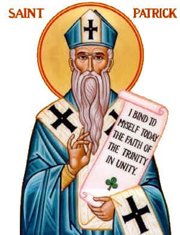The Wanderer,
March 7, 2013C.J.
Doyle Gives His Perspective On The Alleged Vatican Scandals
By PAUL LIKOUDIS
What are Catholics to think of these endless media reports of
alleged scandal, immorality, and infidelity at the Vatican? ( See
the item in this week’s News Notes column about the report to the
Pope from the Commission of Cardinals.) The Wanderer posed this
question to C. Joseph Doyle, executive director of the Catholic
Action League of Massachusetts, for some insight and historical
analysis on the upcoming conclave to elect a new Pope in the midst
of nearly- unprecedented hostile media attention. “ What are
ordinary, faithful Catholics to make of this barrage of negative
media attention on their Church?” The Wanderer asked Doyle.
“ There are two things they should understand about this,” he
answered. “First, the Church is always at war with the world, the
flesh, and the Devil, and the world, the flesh, and the Devil always
reciprocate.
“The elite powers of this world despise the Catholic faith, and
actively seek its destruction. That has always been so, and will
always be so until the end of time. We should also realize, however,
that the reason the Church’s enemies, especially in the press, are
so emboldened at this time in history, is that the Church itself is
undergoing one of the worst periods of heresy and immorality since
the Protestant Revolution 500 years ago. “Dissent, which is to say
heresy, is now normative in countless Catholic institutions: our
Catholic colleges and universities, their parent religious orders,
our elite secondary schools, our Catholic charities and health- care
systems, our Catholic fraternal orders, and even many of our
ordinary parishes. The clergy and religious who govern these
institutions have conformed to the culture, embraced secularism, and
compromised their Catholic identity. It would not be reckless or
irresponsible to say that a majority of Catholic institutions — in
this country at least — are functionally pro-abortion and
pro-homosexual.
“Compounding this is the scandal of sexual abuse, which in
reality is a scandal of homosexual molestation, and homosexual
immorality in our clergy and religious. “ In fact,” Doyle adds, “if
there is a common thread which ties together many of the problems
afflicting the Church, it is this sin of impurity against nature —
not only the acts of sexual abuse themselves, but the bad moral
theology which rationalizes it, the bad dogmatic theology such as
the heresy of universal salvation and God’s unconditional love for
sinners, and the failure of the Church as an institution to root out
these problems.
“One could also add the bad liturgies where the priest is the
narcissistic animator and presider over the people.”
At the times of the Church’s greatest crises — in the so-called
Dark Ages, the Renaissance, the Reformation, the French Revolution —
there has always been “the unspeakable” problem, that is clerical
immorality, especially the sin of sodomy, he noted.
“One of the characteristics of Counter-Reformation Popes, such as
Pope Paul III and particularly Paul IV, St. Pius V, and Sixtus V,
was their willingness to employ the most severe and stringent means
available to exorcise this problem from the Church. Interestingly,
these moral reforms were accompanied by exacting financial reforms.
Paul IV even said he would see the Vatican reduced to penury rather
than have bishops and cardinals wallowing in wealth,” Doyle
continued.
“Their methods to root out clerical sodomy and clerical
immorality ran the gamut from deprivation to imprisonment to
execution. Whatever you think of their methods, one thing is clear:
These Counter-Reformation Popes were serious about reforming the
Church,” Doyle said.
“It is sad to point out,” Doyle said, “that the Church’s
sometimes tepid and ineffectual response to the great moral
challenges of our time — the assault on the sanctity and dignity of
innocent human life and the effort to deform the bedrock institution
of marriage, can often be traced to these sodomite fifth columnists
in the priesthood and episcopacy.”
What does Doyle think of news reports about a “lavender mafia” in
the Curia?
“In the 16th century, the Roman Curia was a cesspool which, like
the Pontine Marshes, needed to be drained. It may be, after 500
years, that a second draining of the swamps is necessary. Catholics,
even the most uninformed, should not be discouraged or disheartened
that scandals are coming to the surface; like lancing a boil, it is
necessary to expel corruption.
“The problems in the Curia are not of recent vintage; they date
back, at least, to the Pontificate of Leo XIII. The modernist cabal,
which went underground in the reign of St. Pius X, began to reappear
as early as the pontificate of Benedict XV, and became a serious
fifth column in the latter part of Pius XII’s reign.”
The Wanderer next asked Doyle if he saw a connection between the
attacks on the Church, and the Holy Father in particular, and the
obvious signs of a broader social collapse, exemplified by the
financial crisis, expanding wars, and the rise of the police state
in many Western countries.
“ The greatest current threat to Western civilization,” Doyle
responded, “is demographic, namely, the failure of European and
North American societies to have a reproductive birthrate. This, in
turn, is directly related to secular society’s rejection of Catholic
morality in the matters of abortion, contraception, divorce, and
homosexuality.
“Also, however, the increasing expansion of state power poses a
threat to the Church, as Catholicism has always been the principal
counterbalance to what would otherwise be the omnipotence of the
state. Historically, the Catholic Church has always been the enemy
of tyrants, whether they were Roman emperors, English kings, or
Communist dictators. Moreover, the Church has always believed, as
Irish President Eamon De Valera said, that the family has
imprescriptible rights which are antecedent and superior to those of
the state.
“That is the real issue behind the media’s attacks on the Church.
As the late Joseph Sobran said, the courtier press is simply the
state’s megaphone.”
What should the cardinals be looking for in a candidate to
replace Benedict XVI?, asked The Wanderer.
“Someone who has the youth, vigor, zeal, and resolve to begin the
systematic reform of the Church.
“The Catholic Reformation and the Counter- Reformation began when
a Pope, Paul III, who was previously viewed as a typical Renaissance
prelate, surprised the world with his determination to appoint holy
men of piety and rectitude to the episcopate and to the College of
Cardinals. These men included the Venetian Gaspar Cantarini, the
first general of the Theatines and future Paul IV Gianpietro Caraffa,
the English theologian and royal family member Reginald Pole, Jacob
Sadoleto, and Matteo Giberti. The Catholic Church is a monarchical
organization; once you have reforming Popes, who intended to promote
reforming bishops and cardinals, that reform becomes a reality,”
Doyle said.
The Wanderer asked Doyle to explain the difference between a
Catholic notion of reform and the notion broadcast by a secular
media.
“Modernist groups, such as Boston’s Voice of the Faithful, talk a
great deal about reform, but what they really mean is surrender to
secular culture, moral laxity, and revolutionary change,” he
explained.
“The Catholic conception of reform, on the contrary, is rooted in
repentance, interior conversion, and the personal pursuit of
holiness. It is restorative, not innovative. It is purifying, not
experimental. It believes not so much in structural change as in
changing the human heart. What liberal groups call reform is
actually tantamount to inculturation and the corruption of the
Church,” Doyle said.
“Pope Benedict understood, profoundly, intuitively, and
reflexively,” said Doyle, “that the Church believes in the good, the
true, and the beautiful. This is what Benedict sought to restore. He
tried to bring truth and beauty back to our liturgy, by restoring
the Traditional Mass and Divine Office, by improving the
translations of the New Mass, and by Catholicizing the ‘great and
tempered beauty’ of the Anglican Prayer Book.
“The attempt to defame him by alleging his complicity in the
sexual abuse scandals was wholly unfounded and utterly unjust and is
an unadulterated example of odium fidei.
Benedict did more to address this problem than anyone else in the
Church. ”As the world awaits the election of a new Pope, there is
one thing to keep in mind," said Doyle.
“The Church will need a Pope who will not only teach and
sanctify, but who will govern firmly, resolutely, and vigorously.
When the world sees that, it will know that the now long overdue
Counter-Reformation has finally begun. We cannot revive the dying
embers of Western civilization until the Church, which created that
civilization, regains her health and vigor.”



